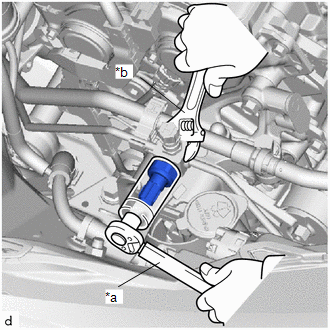Toyota Yaris: Air Conditioning Pressure Sensor / Installation
INSTALLATION
PROCEDURE
1. INSTALL AIR CONDITIONER PRESSURE SENSOR
(a) Remove the vinyl tape from the No. 2 air conditioner tube and accessory assembly.
(b) Sufficiently apply compressor oil to a new air conditioner pressure sensor and the fitting surface of the air conditioner pressure sensor.
Compressor Oil:
ND-OIL 8 or equivalent
| (c) Using a 27 mm deep socket wrench, install the air conditioner pressure sensor as shown in the illustration. Torque: 10.8 N·m {110 kgf·cm, 8 ft·lbf} |
|
(d) Connect the connector.
2. CHARGE AIR CONDITIONING SYSTEM WITH REFRIGERANT
Click here

3. WARM UP ENGINE
Click here

4. INSPECT FOR REFRIGERANT LEAK
Click here

 Removal
Removal
REMOVAL PROCEDURE 1. RECOVER REFRIGERANT FROM REFRIGERATION SYSTEM Click here
2. REMOVE AIR CONDITIONER PRESSURE SENSOR (a) Disconnect the connector...
Other information:
Toyota Yaris XP210 (2020-2025) Owner's Manual: Ignition Switch
Push Button Start Positions The system operates only when the driver is in the vehicle or within operational range while the key is being carried. Each time the push button start is pressed, the ignition switches in the order of off, ACC, and ON...
Toyota Yaris XP210 (2020-2025) Reapir and Service Manual: Check Mode Procedure
CHECK MODE PROCEDURE CHECK MODE: DTC CHECK (a) Select "Check Mode" and proceed with checking using the GTS. Body Electrical > SRS Airbag > Utility Tester Display Check Mode NOTICE: Select Check Mode on the GTS to clear the DTCs (both current and history)...
Categories
- Manuals Home
- Toyota Yaris Owners Manual
- Toyota Yaris Service Manual
- Engine & Hybrid System
- Fuse Panel Description
- Removal
- New on site
- Most important about car
Break-In Period
No special break-in is necessary, but a few precautions in the first 600 miles (1,000 km) may add to the performance, economy, and life of the vehicle.
Do not race the engine. Do not maintain one constant speed, either slow or fast, for a long period of time. Do not drive constantly at full-throttle or high engine rpm for extended periods of time. Avoid unnecessary hard stops. Avoid full-throttle starts.

